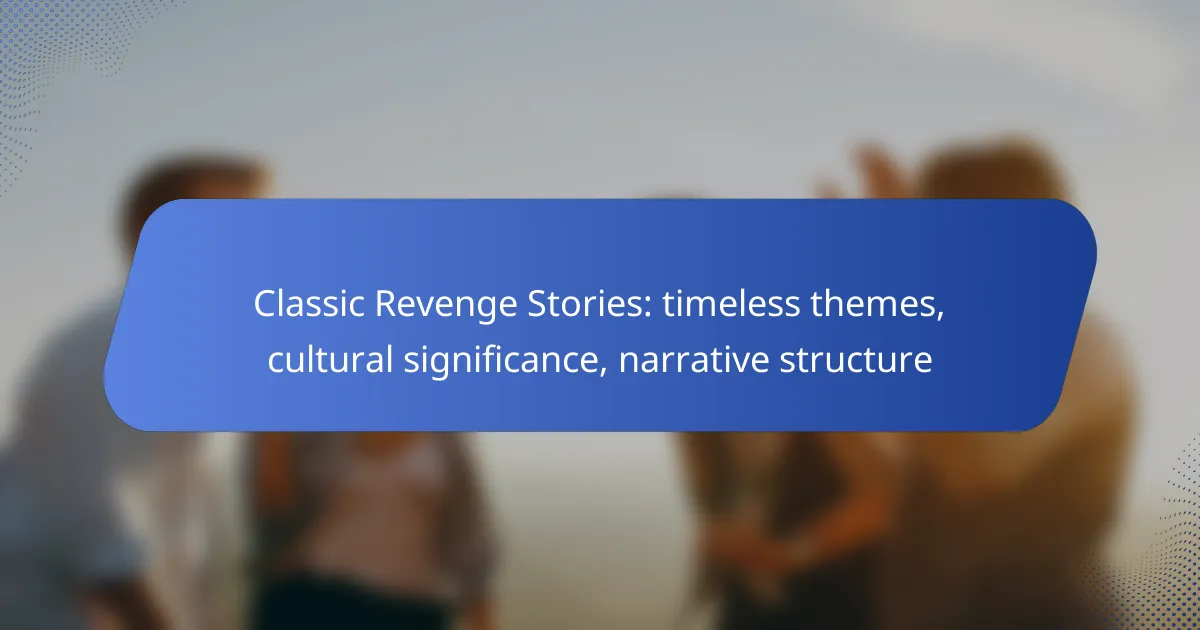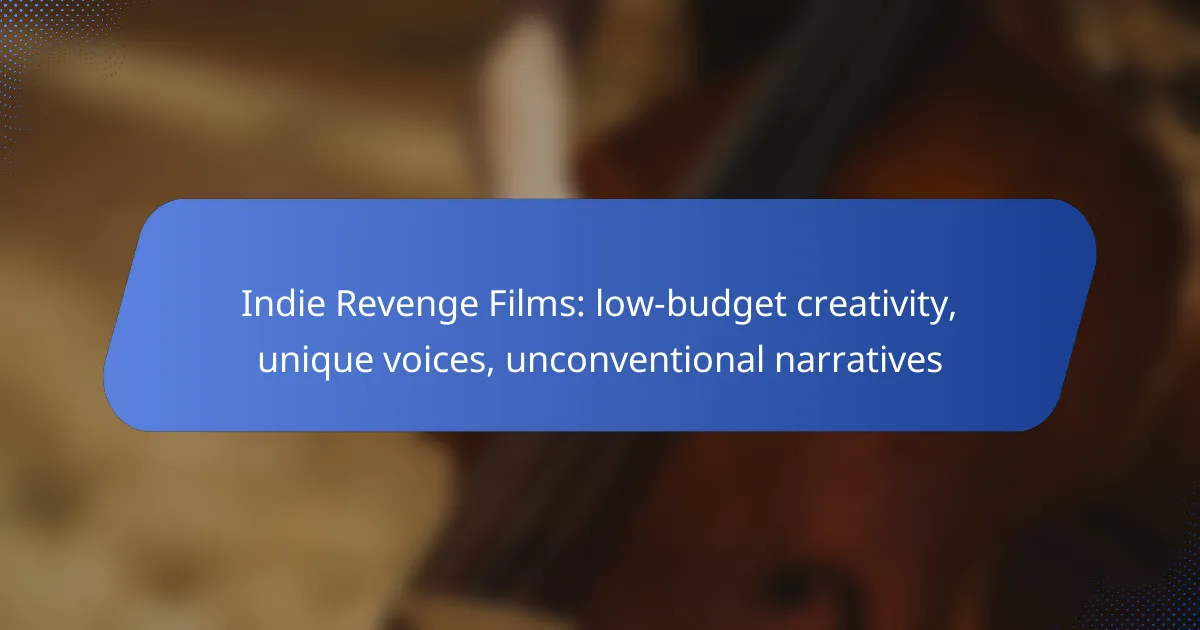Classic revenge stories are a powerful lens through which to examine themes of justice, retribution, and moral ambiguity, particularly in Canadian literature. These narratives not only reflect the complexities of human emotions but also resonate with cultural significance, addressing societal values and historical contexts that shape identity. Typically structured around a protagonist’s quest for vengeance, these tales delve into the consequences and ethical dilemmas that arise from the pursuit of revenge.

What are classic revenge stories in Canadian literature?
Classic revenge stories in Canadian literature explore themes of justice, retribution, and moral ambiguity, often reflecting the complexities of human emotions and societal norms. These narratives typically involve a protagonist seeking vengeance against an antagonist, leading to a dramatic exploration of consequences and ethical dilemmas.
Examples from Canadian authors
Notable Canadian authors have crafted compelling revenge narratives that resonate with readers. For instance, Margaret Atwood’s “Alias Grace” delves into themes of betrayal and vengeance within the context of historical events. Similarly, “The Handmaid’s Tale” presents a dystopian world where revenge plays a crucial role in the characters’ struggles against oppression.
Another significant work is “The Orenda” by Joseph Boyden, which portrays the complexities of revenge in the context of Indigenous and colonial interactions. These examples highlight how Canadian literature uses revenge to probe deeper societal issues.
Key themes in Canadian revenge narratives
Canadian revenge narratives often emphasize the moral ambiguity of vengeance, questioning whether retribution leads to justice or further suffering. Themes of identity, loss, and the impact of historical injustices frequently surface, reflecting the diverse cultural landscape of Canada.
Additionally, the consequences of revenge are a central focus, illustrating how the pursuit of vengeance can lead to a cycle of violence and despair. This exploration encourages readers to reflect on the broader implications of revenge in their own lives and societies.
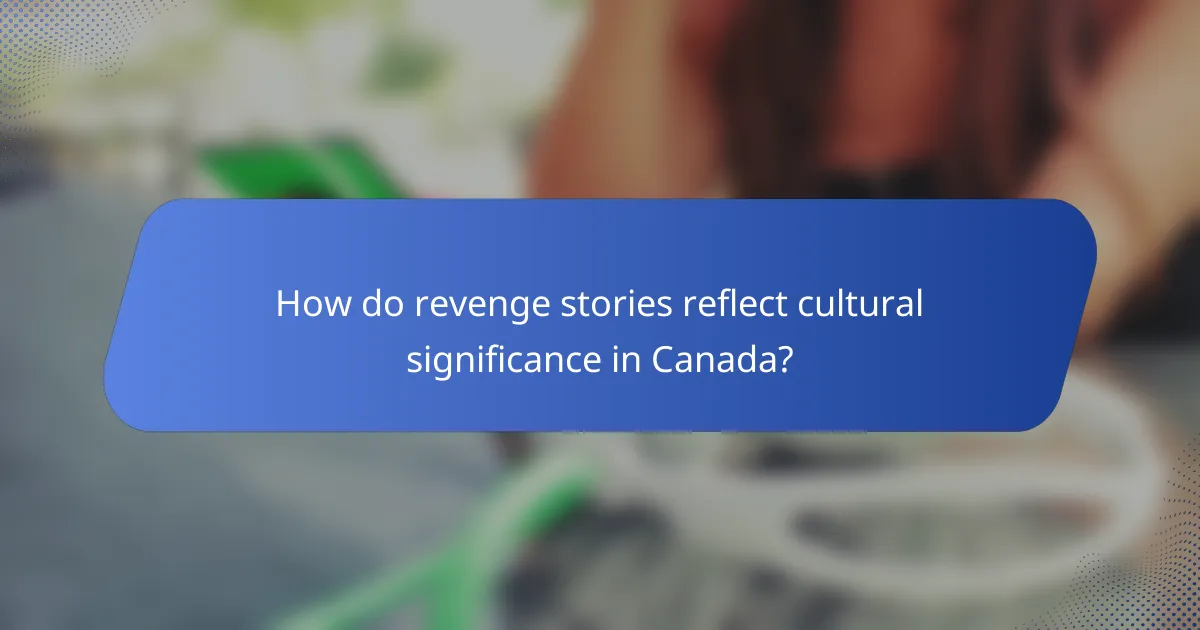
How do revenge stories reflect cultural significance in Canada?
Revenge stories in Canada often mirror the nation’s complex cultural landscape, addressing themes of justice, morality, and identity. These narratives resonate with the Canadian ethos, reflecting societal values and historical contexts that shape the collective consciousness.
Impact on Canadian identity
Revenge stories contribute significantly to Canadian identity by exploring themes of justice and retribution that resonate with the values of fairness and equality. They often depict characters who seek vengeance as a means to restore balance, highlighting the cultural belief in the importance of accountability.
For instance, Indigenous narratives frequently incorporate elements of revenge, illustrating the struggle against colonial injustices. These stories serve not only as entertainment but also as a means of cultural preservation and expression, reinforcing community bonds and shared histories.
Influence of historical events
Historical events in Canada, such as conflicts with Indigenous peoples and colonial struggles, have heavily influenced revenge narratives. These stories often reflect the consequences of past injustices, portraying characters who seek vengeance against oppressors or those who have wronged them.
Examples include literary works that address the repercussions of the fur trade and land dispossession, where characters may pursue revenge to reclaim their dignity and heritage. Such narratives encourage reflection on the past and its impact on present-day Canadian society, fostering a deeper understanding of historical grievances and their ongoing relevance.
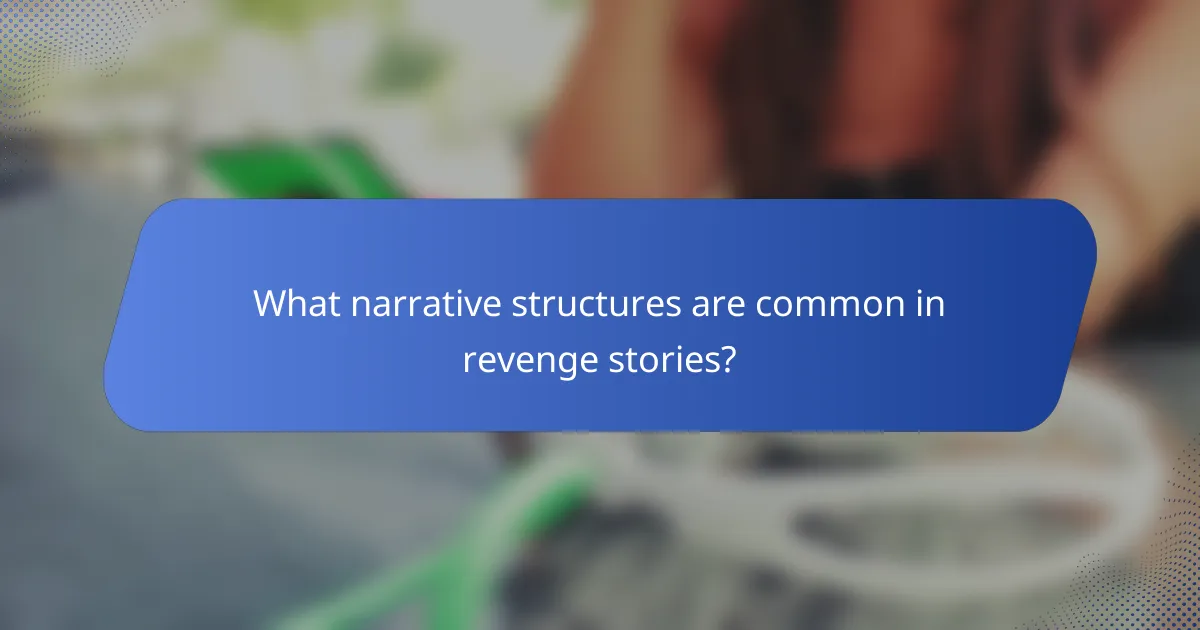
What narrative structures are common in revenge stories?
Revenge stories typically follow a clear narrative structure that includes a setup, conflict, and resolution. This often involves a protagonist who suffers a wrong, seeks vengeance, and ultimately faces the consequences of their actions.
Common plot devices
Revenge narratives frequently utilize specific plot devices to enhance tension and engagement. Common elements include betrayal, moral dilemmas, and the pursuit of justice, which drive the protagonist’s actions. Flashbacks are often employed to reveal the backstory of the conflict, providing context for the revenge.
Another prevalent device is the ticking clock, where the protagonist must act within a certain timeframe, heightening suspense. This can create urgency and lead to unexpected twists as the story unfolds.
Character archetypes in revenge tales
Character archetypes play a crucial role in shaping revenge stories. The avenger, often a wronged individual, is central to the narrative, embodying traits like determination and resilience. They are typically pitted against an antagonist who represents the source of their suffering, often characterized by cunning or ruthlessness.
Supporting characters, such as allies or mentors, can provide guidance or complicate the avenger’s journey. These characters may have their own motivations, which can add layers to the revenge plot, creating a rich tapestry of relationships and conflicts.

What are the psychological themes in revenge narratives?
Revenge narratives often explore deep psychological themes such as justice, betrayal, and the human desire for retribution. These stories resonate because they tap into fundamental emotions and moral dilemmas, reflecting how individuals cope with feelings of hurt and injustice.
Motivations behind revenge
The motivations for seeking revenge can vary widely, often rooted in personal experiences of betrayal, loss, or humiliation. Common drivers include a desire for justice, the need to restore one’s honor, or the urge to regain control over a situation that felt unjust.
In many cultures, revenge is seen as a way to balance the scales of justice, providing a sense of closure. For instance, in literature, characters may pursue revenge to reclaim their dignity or to punish those who have wronged them, illustrating how personal grievances can lead to a cycle of retaliation.
Consequences of revenge
The consequences of revenge can be profound and multifaceted, often leading to a cycle of violence and further conflict. While the initial act of revenge might provide a temporary sense of satisfaction, it frequently results in regret, guilt, or unintended repercussions that can harm both the avenger and the target.
Additionally, revenge can strain relationships and create lasting animosities. For example, in many classic stories, the pursuit of vengeance ultimately leads to the downfall of the avenger, highlighting the destructive nature of such actions and the importance of seeking healthier resolutions to conflict.
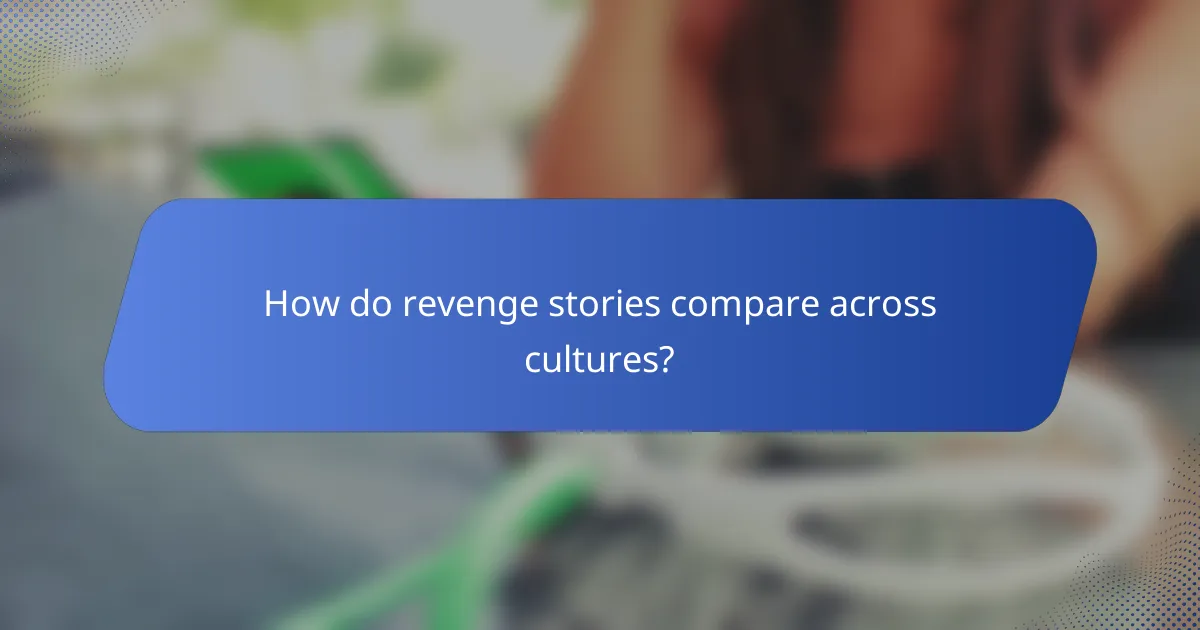
How do revenge stories compare across cultures?
Revenge stories vary significantly across cultures, reflecting unique societal values and moral codes. While the core theme of retribution remains constant, the methods, motivations, and consequences often differ based on cultural context.
Cross-cultural examples
In Western literature, Shakespeare’s “Hamlet” exemplifies revenge driven by personal betrayal and moral ambiguity. In contrast, the Japanese tale of “The Tale of the Heike” focuses on honor and the consequences of revenge on family and society. Similarly, in African folklore, stories like “The Lion and the Mouse” illustrate the idea of revenge intertwined with justice and moral lessons.
These examples highlight how cultural narratives shape the portrayal of revenge, with varying emphasis on individual versus collective consequences. Each story serves as a reflection of the cultural values surrounding justice and morality.
Similarities and differences in themes
Common themes in revenge stories include justice, morality, and the cycle of violence. Many cultures depict revenge as a necessary response to wrongdoing, often portraying the avenger as a tragic hero. However, the consequences of revenge can differ; some cultures emphasize redemption, while others focus on the inevitable downfall of the avenger.
Differences arise in the portrayal of justice systems and societal norms. For instance, in some cultures, revenge is seen as a personal duty, while in others, it may be viewed as a failure to uphold communal harmony. Understanding these themes helps in grasping the broader implications of revenge narratives across various societies.
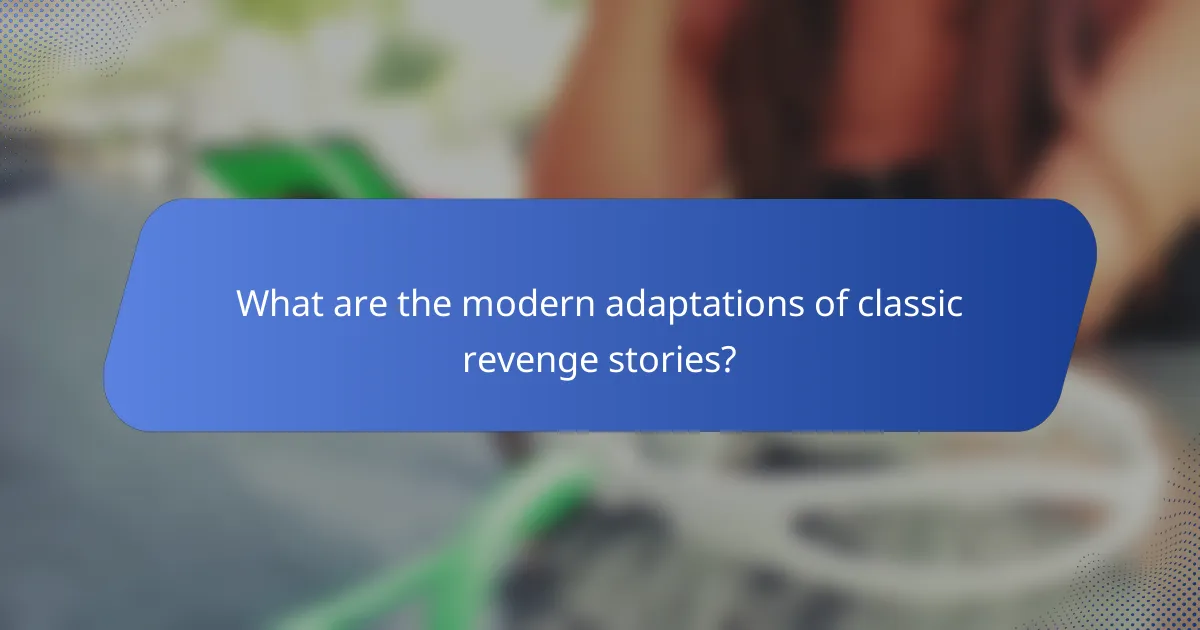
What are the modern adaptations of classic revenge stories?
Modern adaptations of classic revenge stories often reinterpret timeless themes, focusing on personal justice and moral dilemmas. These adaptations can be found across various media, including film and literature, reflecting contemporary societal issues and cultural nuances.
Film adaptations in Canada
Canadian cinema has produced several notable film adaptations of classic revenge narratives, often blending local culture with universal themes. Films like “The Sweet Hereafter” and “Incendies” explore revenge through the lens of personal loss and societal injustice, resonating deeply with audiences.
These adaptations frequently emphasize character development and moral complexity, inviting viewers to reflect on the consequences of vengeance. The use of Canadian landscapes and settings further enhances the emotional weight of these stories, making them uniquely impactful.
Contemporary literature examples
In contemporary literature, authors often draw inspiration from classic revenge tales, reimagining them in modern contexts. Works such as “Gone Girl” by Gillian Flynn and “The Kite Runner” by Khaled Hosseini illustrate how revenge can be intertwined with themes of betrayal and redemption.
These narratives typically focus on the psychological aspects of revenge, exploring the motivations and repercussions of the characters’ actions. Readers are often left questioning the morality of revenge, making these stories relevant to today’s ethical discussions.
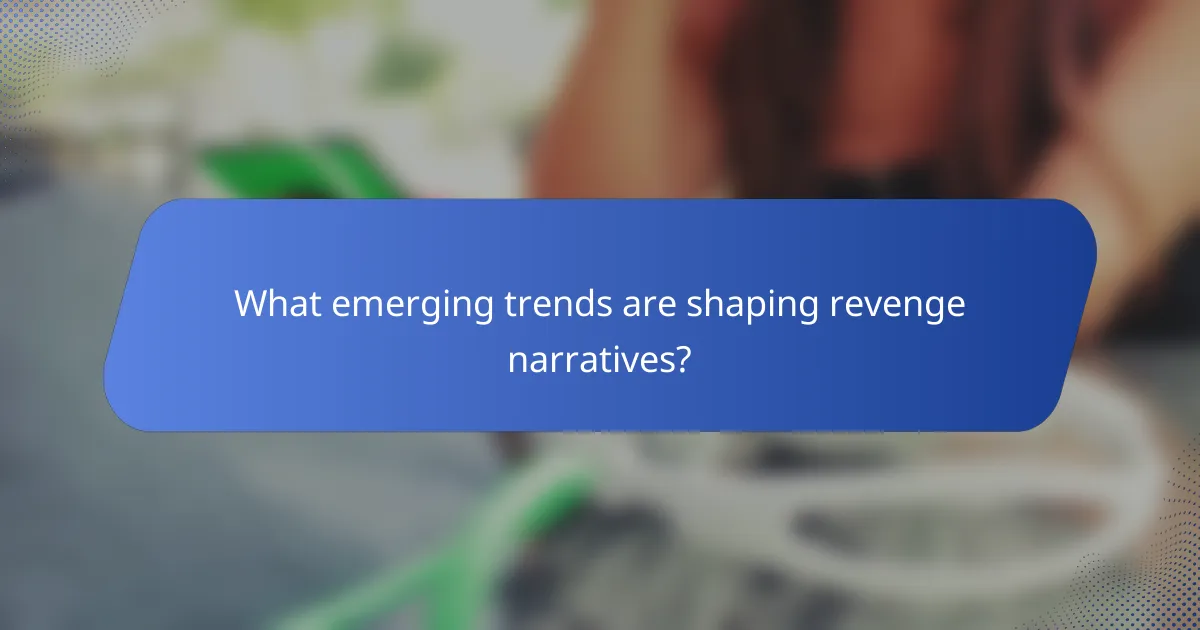
What emerging trends are shaping revenge narratives?
Emerging trends in revenge narratives reflect evolving societal values and technological advancements. Themes of justice, morality, and the consequences of vengeance are increasingly intertwined with contemporary issues such as mental health, social media influence, and systemic injustice.
Incorporation of Technology
Modern revenge stories often leverage technology as a critical plot device. Social media platforms, hacking, and digital surveillance can amplify the stakes and consequences of revenge, making the narrative more relatable to today’s audience. For instance, a character might seek revenge through online shaming or cyberbullying, highlighting the darker side of digital interactions.
Focus on Psychological Depth
Recent narratives delve deeper into the psychological motivations behind revenge. Writers are exploring the emotional turmoil and moral dilemmas faced by characters, presenting revenge not just as an act but as a complex emotional journey. This shift encourages audiences to empathize with the avenger, questioning the morality of their actions.
Social Justice Themes
Many contemporary revenge stories are intertwined with themes of social justice, addressing systemic inequalities and injustices. Characters often seek revenge against oppressive systems or individuals, reflecting a growing desire for empowerment and accountability. This trend resonates with audiences who are increasingly aware of social issues and advocate for change.
Blurring of Moral Boundaries
Modern revenge narratives frequently blur the lines between right and wrong, challenging traditional moral frameworks. Characters may be portrayed as anti-heroes, leading audiences to grapple with their own perceptions of justice and retribution. This complexity adds depth to the narrative, prompting discussions about the nature of vengeance and its consequences.






